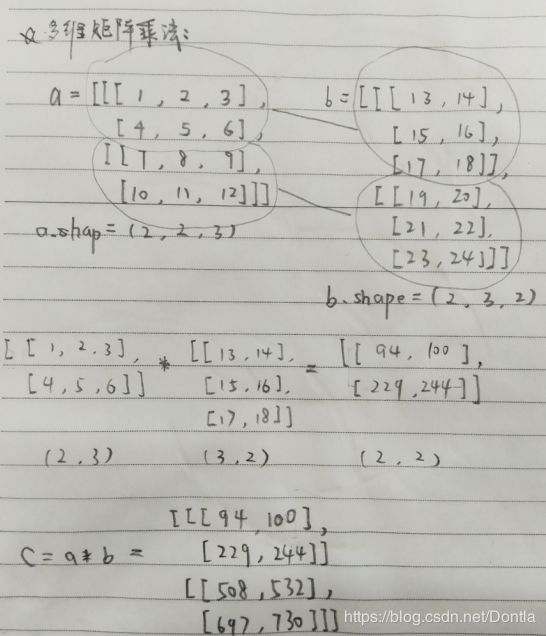tensorflow tf.matmul() (多维)矩阵相乘(多维矩阵乘法)
@tf_export("matmul")
def matmul(a,
b,
transpose_a=False,
transpose_b=False,
adjoint_a=False,
adjoint_b=False,
a_is_sparse=False,
b_is_sparse=False,
name=None):
"""Multiplies matrix `a` by matrix `b`, producing `a` * `b`.
将矩阵a与矩阵b相乘,得出a * b。
The inputs must, following any transpositions, be tensors of rank >= 2
where the inner 2 dimensions specify valid matrix multiplication arguments,
and any further outer dimensions match.
在进行任何换位后,输入必须为(秩?)> = 2的张量,其中内部2维指定有效的矩阵乘法自变量,
并且任何其他外部维匹配。
Both matrices must be of the same type. The supported types are:
`float16`, `float32`, `float64`, `int32`, `complex64`, `complex128`.
两种矩阵必须属于同一类型。 支持的类型有:`float16`,`float32`,`float64`,`int32`,`complex64`,`complex128`。
Either matrix can be transposed or adjointed (conjugated and transposed) on
the fly by setting one of the corresponding flag to `True`. These are `False`
by default.
通过将相应标志之一设置为“ True”,可以即时对矩阵进行转置或连接(共轭和转置)。 这些默认为False。
If one or both of the matrices contain a lot of zeros, a more efficient
multiplication algorithm can be used by setting the corresponding
`a_is_sparse` or `b_is_sparse` flag to `True`. These are `False` by default.
This optimization is only available for plain matrices (rank-2 tensors) with
datatypes `bfloat16` or `float32`.
如果一个或两个矩阵都包含大量零,则可以通过将相应的“ a_is_sparse”或“ b_is_sparse”标志,
设置为“ True”来使用更有效的乘法算法。 这些默认为False。
此优化仅适用于数据类型为bfloat16或float32的普通矩阵(秩2张量)。
For example:
```python
# 2-D tensor `a`
# [[1, 2, 3],
# [4, 5, 6]]
a = tf.constant([1, 2, 3, 4, 5, 6], shape=[2, 3])
# 2-D tensor `b`
# [[ 7, 8],
# [ 9, 10],
# [11, 12]]
b = tf.constant([7, 8, 9, 10, 11, 12], shape=[3, 2])
# `a` * `b`
# [[ 58, 64],
# [139, 154]]
c = tf.matmul(a, b)
# 3-D tensor `a`
# [[[ 1, 2, 3],
# [ 4, 5, 6]],
# [[ 7, 8, 9],
# [10, 11, 12]]]
a = tf.constant(np.arange(1, 13, dtype=np.int32),
shape=[2, 2, 3])
# 3-D tensor `b`
# [[[13, 14],
# [15, 16],
# [17, 18]],
# [[19, 20],
# [21, 22],
# [23, 24]]]
b = tf.constant(np.arange(13, 25, dtype=np.int32),
shape=[2, 3, 2])
# `a` * `b`
# [[[ 94, 100],
# [229, 244]],
# [[508, 532],
# [697, 730]]]
c = tf.matmul(a, b)
# Since python >= 3.5 the @ operator is supported (see PEP 465).
# In TensorFlow, it simply calls the `tf.matmul()` function, so the
# following lines are equivalent:
由于python> = 3.5,因此支持@运算符(请参阅PEP 465)。
在TensorFlow中,它仅调用`tf.matmul()`函数,因此以下几行是等效的:
d = a @ b @ [[10.], [11.]]
d = tf.matmul(tf.matmul(a, b), [[10.], [11.]])
Args:
a: `Tensor` of type `float16`, `float32`, `float64`, `int32`, `complex64`,
`complex128` and rank > 1.
类型为`float16`,`float32`,`float64`,`int32,`complex64`,`complex128`和秩> 1的`Tensor`。
b: `Tensor` with same type and rank as `a`.
具有与a相同类型和秩的Tensor。
transpose_a: If `True`, `a` is transposed before multiplication.
如果为True,则在相乘之前对a进行转置。
transpose_b: If `True`, `b` is transposed before multiplication.
如果为True,则在相乘之前将b换位。
adjoint_a: If `True`, `a` is conjugated and transposed before
multiplication.
如果为True,则在相乘之前对a进行共轭和转置。
adjoint_b: If `True`, `b` is conjugated and transposed before
multiplication.
如果为True,则在相乘之前对b进行共轭和转置。
a_is_sparse: If `True`, `a` is treated as a sparse matrix.
如果为True,则将a视为稀疏矩阵。
b_is_sparse: If `True`, `b` is treated as a sparse matrix.
如果为True,则将b视为稀疏矩阵。
name: Name for the operation (optional).
操作名称(可选)。
Returns:
A `Tensor` of the same type as `a` and `b` where each inner-most matrix is
the product of the corresponding matrices in `a` and `b`, e.g. if all
transpose or adjoint attributes are `False`:
与`a`和`b`具有相同类型的`张量`,其中每个最里面的矩阵是`a`和`b`中对应矩阵的乘积,
例如 如果所有转置或伴随属性均为False:
`output`[..., i, j] = sum_k (`a`[..., i, k] * `b`[..., k, j]),
for all indices i, j.
Note: This is matrix product, not element-wise product.
这是矩阵乘积,而不是元素乘积。
Raises:
ValueError: If transpose_a and adjoint_a, or transpose_b and adjoint_b
are both set to True.
"""
with ops.name_scope(name, "MatMul", [a, b]) as name:
if transpose_a and adjoint_a:
raise ValueError("Only one of transpose_a and adjoint_a can be True.")
if transpose_b and adjoint_b:
raise ValueError("Only one of transpose_b and adjoint_b can be True.")
if context.executing_eagerly():
if not isinstance(a, (ops.EagerTensor, _resource_variable_type)):
a = ops.convert_to_tensor(a, name="a")
if not isinstance(b, (ops.EagerTensor, _resource_variable_type)):
b = ops.convert_to_tensor(b, name="b")
else:
a = ops.convert_to_tensor(a, name="a")
b = ops.convert_to_tensor(b, name="b")
# TODO(apassos) remove _shape_tuple here when it is not needed.
a_shape = a._shape_tuple() # pylint: disable=protected-access
b_shape = b._shape_tuple() # pylint: disable=protected-access
if (not a_is_sparse and
not b_is_sparse) and ((a_shape is None or len(a_shape) > 2) and
(b_shape is None or len(b_shape) > 2)):
# BatchMatmul does not support transpose, so we conjugate the matrix and
# use adjoint instead. Conj() is a noop for real matrices.
if transpose_a:
a = conj(a)
adjoint_a = True
if transpose_b:
b = conj(b)
adjoint_b = True
return gen_math_ops.batch_mat_mul(
a, b, adj_x=adjoint_a, adj_y=adjoint_b, name=name)
# Neither matmul nor sparse_matmul support adjoint, so we conjugate
# the matrix and use transpose instead. Conj() is a noop for real
# matrices.
if adjoint_a:
a = conj(a)
transpose_a = True
if adjoint_b:
b = conj(b)
transpose_b = True
use_sparse_matmul = False
if a_is_sparse or b_is_sparse:
sparse_matmul_types = [dtypes.bfloat16, dtypes.float32]
use_sparse_matmul = (
a.dtype in sparse_matmul_types and b.dtype in sparse_matmul_types)
if ((a.dtype == dtypes.bfloat16 or b.dtype == dtypes.bfloat16) and
a.dtype != b.dtype):
# matmul currently doesn't handle mixed-precision inputs.
use_sparse_matmul = True
if use_sparse_matmul:
ret = sparse_matmul(
a,
b,
transpose_a=transpose_a,
transpose_b=transpose_b,
a_is_sparse=a_is_sparse,
b_is_sparse=b_is_sparse,
name=name)
# sparse_matmul always returns float32, even with
# bfloat16 inputs. This prevents us from configuring bfloat16 training.
# casting to bfloat16 also matches non-sparse matmul behavior better.
if a.dtype == dtypes.bfloat16 and b.dtype == dtypes.bfloat16:
ret = cast(ret, dtypes.bfloat16)
return ret
else:
return gen_math_ops.mat_mul(
a, b, transpose_a=transpose_a, transpose_b=transpose_b, name=name)

通过结果可以看出,两个多维矩阵再相乘时,它们除了后两维之外的维度必须相同,否则怎能做到一一对应呢?
比如a的维度是(2,2,3),b的维度是(2,3,2),它们除了最后两维之外的维度2必须相同,而最后两维需要满足矩阵乘法要求,一个是(i,j),另一个必须是(j,k)。
相乘后,除后两维之外的维度不变,后两维变成(i,k),如(…,i,j)*(…,j,k)= (…,i,k)
参考文章:[tensorflow] 多维矩阵的乘法